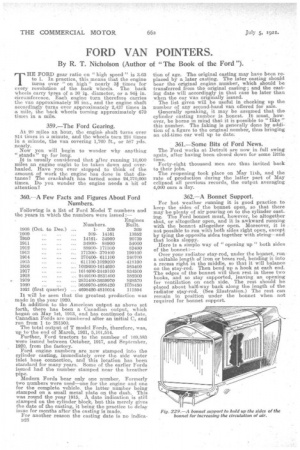FORD VAN POINTERS.
Page 24

If you've noticed an error in this article please click here to report it so we can fix it.
By R. T. Nicholson (Author of "The Book of the Ford ").
THE FORD gear ratio on " high speed" is 3.63 to 1. In practice, this means that the engine turns over "on high" nearly ,3i times for every revolution of the back wheels. The back wheels carry tyres of a 30 in. diameter, or a 941 in. circumference. Each engine turn therefore carries the van approximately 26 ins., and the engine shaft accordingly turns over approximately 2,437 times in a mile, the back wheels turning approximately670 times in a mile.
359.—The Ford Gearing.
At 20 mites an hour, the enginh shaft turns over 814 times in a minute, and the wheels turn 224 times in a minute, the van covering 1,760 ft., or 587 yds. nearly.
Now you will begin to wonder why anything "stands" up for long.
It is usually considered that after running 10,000 miles an engine ought to be taken down and overhauled. Have you ever stopped to think of the amount of work the engine has done in that distance? The crankshaft has turned some 24,370,000 times. Do you wonder the engine needs a bit of attention?
360.—A Few Facts and Figures About Ford Numbers.
Following is a list of Ford Model T numbers and the years in which the numb-era were issued:— It will be seen that the greatest production was made in the year 1920. In addition to the American output as above set forth, there has been a Canadian output, which began on May 1st, 1913, and has continued to date. Canadian Fords are numbered after an initial C, and run from 1 to 291500.
The total output of T model Fords, therefore, was, up to-the end of March, 1921, 5,101,514.
Further, Ford tractors to the number of 169.583 were issued between October, 1917, and September, 1920, from the factory.
Ford engine numbers are now stamped into the -cylinder casting, immediately over the side water inlet hose connection, and this location has been standard for many years. Some of the earlier Fords issued had the number stamped near the breather pipe.
Modern Fords bear only one number. Formerly two numbers were used—one for the engine and one for the complete vehicle, the latter number being stamped On a small metal plate on the dash. This was round the year 1915. A. date indication is still stamped on the cylinder block, but this merely gives the date of the casting, it being the practice to delay issue for months after the casting is made. For another reason the casting date is no indicaD28 tion of age. The original casting may have been replaced by a later casting. The later casting should bear the original engine number, which should be transferred from the original casting; and the casting date will accordingly in that case be later than when the car was originally issued. The list given will be useful in checking up the number of any second-hand van offered for sale.
Generally speaking, it may be assumed that the cylinder casting number is -honest. It must, however, be borne in mind that it is possible to "fake this number. The faking is generally done by addition of a figure to the original number, thus bringing an old-time car well up to date.
361.—Some Bits of Ford News.
The Ford works at Detroit are now in fidl swing again, after having been closed down for some little time.
Forty-eight thousand men are thus invited back to their jobs. The reopening took place on gay llth, and the rate of production during the latter part of May eclipsed all previous records, the output averaging 4,000 cars a day.
362.--A Bonnet Support.
For hot weather running it is good practice. to keep the sides ofthe bonnet open, so that there may be plenty of air pouring on to the cylinder casting. The Ford bonnet must, however, be altogether shut, or altogether open, and it is awkward running with the bonnet altogether open. Moreover, it is not possible to run with both sides right open, except by tying the opposite sides together with string—and that looks sloppy.
Here is a simple way of "opening up " 'both sides of the bonnet:— Over your radiator stay-rod, under the bonnet, run a suitable length of iron or brass rod, bending it into a recess right in the middle, so that it will balance on the stay-rod: Then bend up a hook at each end. The edges of the bonnet will then rest in these two hooks, and so stay supported, leaving an opening for ventilation on each side. The rest should be placed about half-way back along the length of the radiator stay-rod. (See illustration.) The rest can remain in position under the bonnet when not required for bonnet support.
































